Today, it is more important than ever to connect, meet, and engage with employees. That is where employee engagement software takes the stage. They’re created to facilitate internal communications, increase morale, foster collaboration, and track employee satisfaction, those drivers that yield more productivity and less turnover. Whatever your title, remote developer, freelancer designer, or cross-functional marketing manager, the right engagement software can revolutionize the workplace experience.
This is a list of the top 10 employee engagement software tools based on some major consideration factors: ease of use, ability to integrate with other business tools, quality of feedback and analytics, customization options, and overall value for money. We’ve also considered the diversity of team needs, from small startups to large enterprises, and included both free and premium options.
These software solutions help HR teams, managers, and team leaders create a positive work environment culture and make sure that everyone has a voice. In this day and age, with hybrid and remote work being the standard, having a solid employee engagement strategy supported by efficient software isn’t a luxury but an imperative for long-term achievement. Below are the most suitable tools to elevate your team’s engagement to the next level.
Criteria for Selecting the Best Employee Engagement Tools
In selecting top employee engagement tools, some points are most important in providing value and effectiveness. First is ease of use, simple to use and navigate by employees and HR personnel with little or no special training. Also critical are easy integration with platforms such as Slack, Microsoft Teams, or Google Workspace. An employee engagement platform of high quality would comprise survey customization, real-time pulse checks, and anonymous feedback to measure employee sentiment properly.
Quality reporting and analytics functions are needed to translate feedback into actionable intelligence. Customization and flexibility allow companies to adapt features like dashboards, rewards programs, and tone of communication to their own unique culture. Staff reward and recognition schemes are very important to staff motivation, and scalability means that the platform will grow with your staff. That’s why choosing solutions that support employee rewards and recognition can make a lasting impact on how engaged and valued employees feel in the long run. To reinforce recognition programs beyond software, many HR teams pair digital badges with an Awards collection of premium crystal awards, giving employees a tangible, enduring symbol of achievement. Crystal trophies for milestones, peer-nominated wins, or quarterly MVPs amplify program credibility and fit perfectly alongside in-app kudos during hybrid or in-person ceremonies.
Security of data and compliance with standards like GDPR are also important to ensure that sensitive employee data remains secure. Strong customer support, responding quickly, is an important factor as well for the simplicity of setup and use. Finally, the tool should be value for money, with the cost reflecting the quality and breadth of features offered. These requirements overall help decide tools that not only inspire employees but also align organizational aims and culture.
Comparison Between Different Employee Engagement Tools
Here is the table with the tool name, website, description, and pricing:
| Tool Name | Website | Description | Pricing |
| Officevibe | officevibe.com | Pulse surveys and anonymous feedback for team engagement. | Free plan available; Paid from $5/user/month |
| Culture Amp | cultureamp.com | Comprehensive employee engagement and analytics platform. | Request a quote |
| 15Five | 15five.com | OKRs, weekly check-ins, and performance tools. | From $4/user/month |
| TinyPulse | tinypulse.com | Weekly employee feedback and recognition tool. | Custom pricing |
| Lattice | lattice.com | Engagement, reviews, and growth tracking in one tool. | Starts at $11/user/month |
| Motivosity | motivosity.com | Peer recognition, rewards, and performance analytics. | Free plan; Paid from $4/user/month |
| Engagedly | engagedly.com | Engagement, learning, performance, and goal setting. | Custom pricing (based on modules used) |
| Qualtrics EmployeeXM | qualtrics.com | Advanced feedback and analytics for workforce experience. | Custom pricing (enterprise-level tool) |
| Peakon (Workday) | workday.com | Real-time engagement insights integrated with Workday. | Custom pricing (Workday subscription required) |
| Bonusly | bonusly.com | Points-based recognition system for employee appreciation. | From $2/user/month |
List of 10 Employee Engagement Tools
1. Officevibe
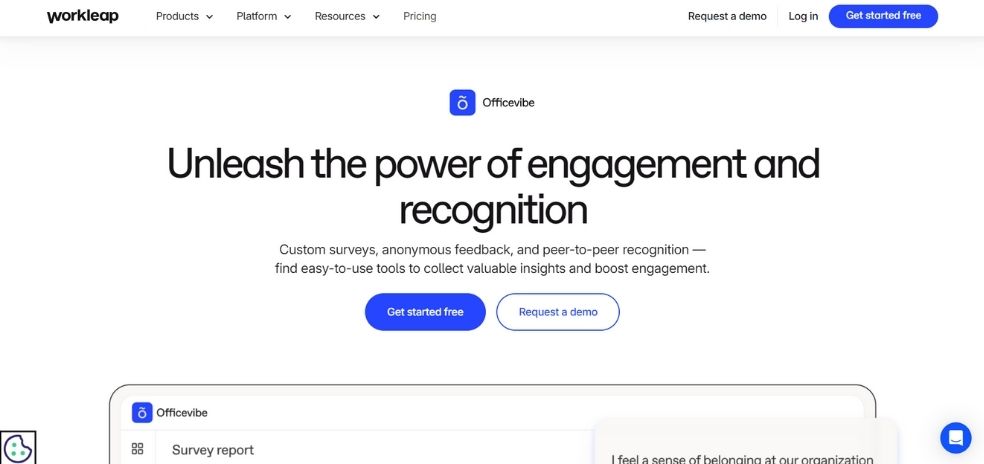
Officevibe activates employees and makes company culture responsible by submitting weekly pulse polls and anonymous commentary. It shares with managers real-time, action-specific information concerning workers’ blissfulness and activation in easy-to-read reports and graphs. It supports open exchange and keeps from permitting issues to get to be an issue.
It can even be used by teams to formulate goals and chart advancements. Its ease of use and emphasis on actionable feedback place it as the best fit for small and medium enterprises requiring amplified team productivity and morale. It is also a great fit for managers requiring quick feedback on the performance of their teams and what they require.
Features:
- Pulse surveys
- Anonymous feedback
- Team reports
- Goal tracking
- Customizable questions
Pros:
- Easy to use and implement
- Provides actionable insights
Cons:
- Limited advanced analytics
- May not suit large enterprises
Who should use it:
Best for small to mid-sized teams seeking regular feedback and simple engagement tracking.
2. Culture Amp
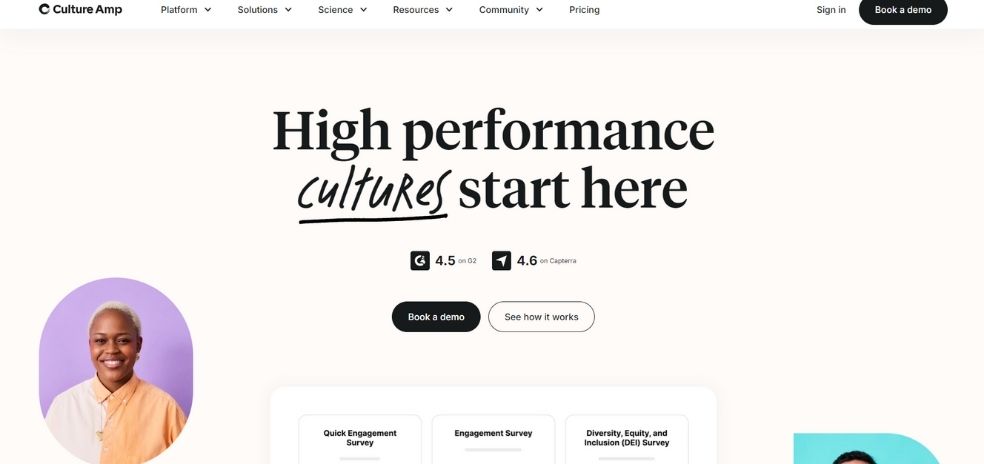
Culture Amp is a leading employee engagement platform used to drive maximum company culture with data-backed insights. It offers integrated surveys, performance management, and robust analytics for the measurement of engagement, growth, and feedback. HR leaders can compare results and benchmark against industries on the platform.
Culture Amp is ideal for businesses that want to connect employee performance to business results. Having a robust support structure and simplicity enables companies to create open, productive spaces. It is most appropriate for medium and large companies with a long-term commitment and a growth strategy.
Features:
- Engagement and pulse surveys
- Performance reviews
- Employee development tools
- Feedback and goal setting
- Benchmarking across industries
Pros:
- Data-driven insights
- Strong support and resources
Cons:
- Pricing may be high for small teams
- Can have a learning curve
Who should use it:
Ideal for mid to large-sized companies aiming for in-depth employee experience analysis.
3. 15Five
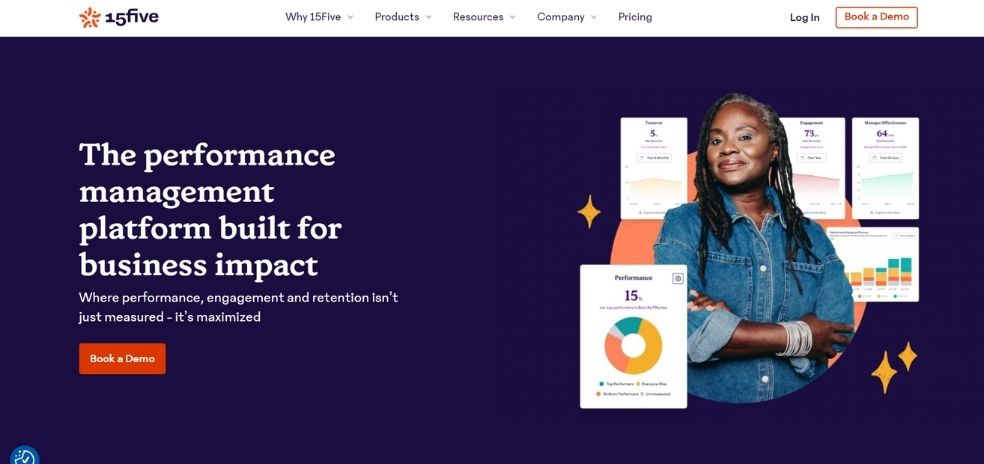
15Five is an OKR performance engagement and tracking platform with feedback and constant check-ins. The platform helps build high-performance teams for managers via open communication and continuous recognition. The platform is designed to automatically enforce weekly check-ins, goal alignment, and coaching conversations as part of its main capabilities.
By incorporating capabilities such as 1-on-1 agendas, performance reviews, and feedback loops, 15Five fosters a culture of growth and culture of accountability. It is quite effective in data-driven businesses in which transparency and employee growth matter most. Ideal for start-ups as well as growth businesses with a desire to tie collective action to business outcomes.
Features:
- Weekly check-ins
- OKR tracking
- Continuous feedback
- Performance reviews
- 1-on-1 meeting agendas
Pros:
- Encourages frequent communication
- Helps align individual and company goals
Cons:
- Might be overwhelming for small teams
- Some features require higher-tier plans
Who should use it:
Great for performance-driven organizations focused on goal tracking and employee development.
Suggested Blog: Best Enterprise Chatbot Solutions
4. TinyPulse
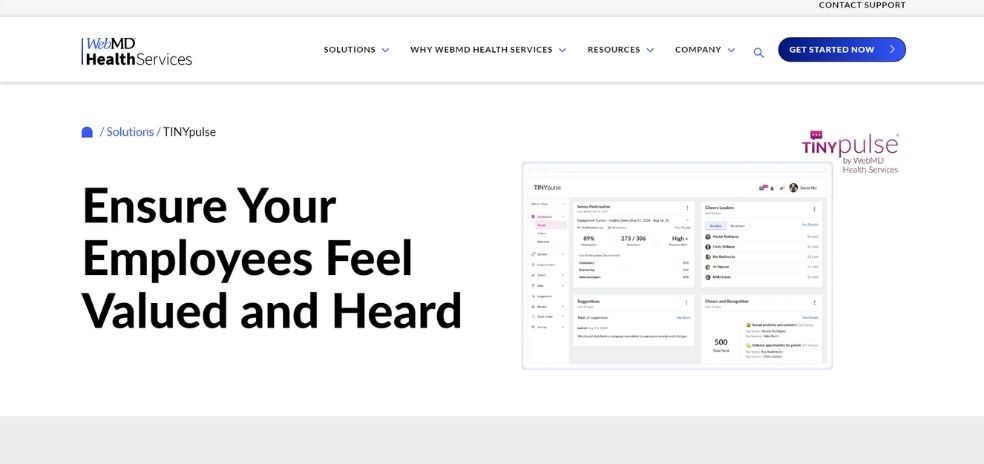
TinyPulse allows employees to give quick and simple feedback via weekly single-question polls and anonymous comments. Its lightweight platform alerts managers to the feelings of the employees, identifies patterns, and reacts immediately. It also has peer-to-peer appreciation tools, customized polls, and reporting.
TinyPulse allows employees and leaders to communicate often and build trust and openness in the culture. Its ease of use is appropriate for small to medium enterprises seeking low-barrier engagement platforms. It’s particularly appropriate for new-to-employee-engagement businesses that desire a light-to-use and effective platform.
Features:
- Pulse surveys
- Anonymous feedback
- Peer recognition
- Custom reports
- Engagement trend analysis
Pros:
- Promotes open and honest feedback
- Simple interface for quick adoption
Cons:
- Limited integration options
- Not ideal for complex organizations
Who should use it:
Perfect for startups or small companies that value employee transparency and recognition.
5. Lattice
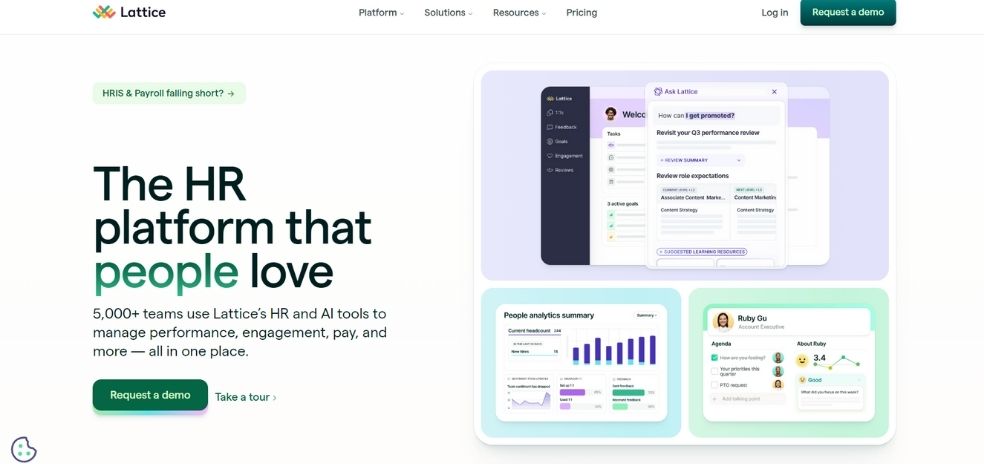
Lattice unifies employee engagement, performance management, and career development into one solution. Lattice provides features such as engagement surveys, OKRs, performance reviews, continuous feedback, and career planning. This solution equips HR teams to link employee growth with business strategy and develop an open work culture.
Lattice also contains analytics so that businesses can identify trends and act accordingly. It’s a powerful tool that is most suitable for mid to large organizations with an emphasis on structured growth and performance frameworks. Lattice is unique because it is flexible and can help employees achieve long-term success.
Features:
- Performance reviews
- Goal setting (OKRs)
- Feedback and praise
- Engagement surveys
- Growth planning
Pros:
- All-in-one performance and engagement tool
- Great for structured growth tracking
Cons:
- Higher learning curve
- Can be costly for small teams
Who should use it:
Ideal for HR teams in growing or large organizations seeking a robust engagement and development platform.
6. Motivosity
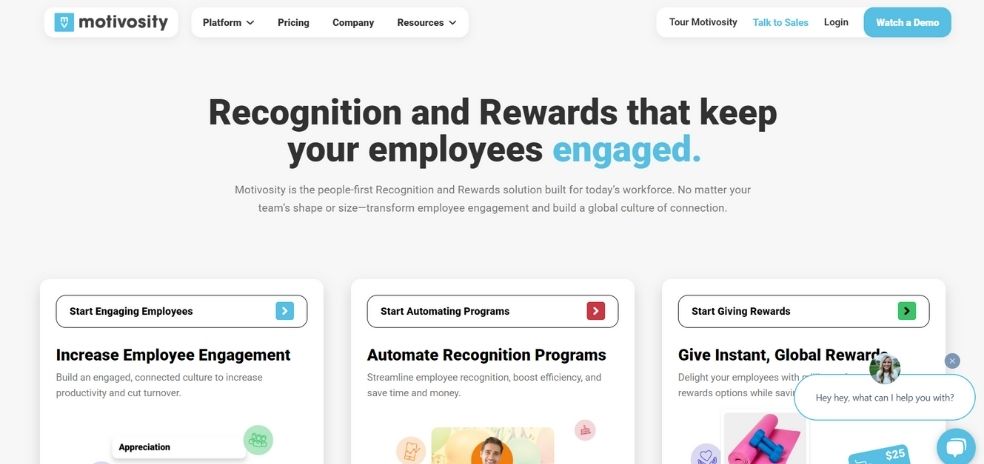
Motivosity is founded upon staff appreciation and reward, which promotes a culture of appreciation and peer-to-peer dialogue. Employees can celebrate publicly and in return earn rewards that they can use to purchase on the platform. Managerial features of coaching, analytics, and engagement tracking are available.
Motivosity allows teams to build tighter relationships and better morale by giving frequent and visible rewards to employees. Its social-class platform maintains the experience to be fun and engaging. It is most suited for culture-based organizations that require fostering staff motivation and job satisfaction, and is most suitable for organizations that subscribe to casual, consistent recognition of teamwork.
Features:
- Peer-to-peer recognition
- Custom rewards
- Engagement analytics
- Manager development tools
- Company-wide praise wall
Pros:
- Boosts morale through recognition
- Strong focus on company culture
Cons:
- Limited performance management tools
- Interface can be overwhelming
Who should use it:
Best for culture-driven companies prioritizing peer recognition and employee appreciation.
7. Engagedly
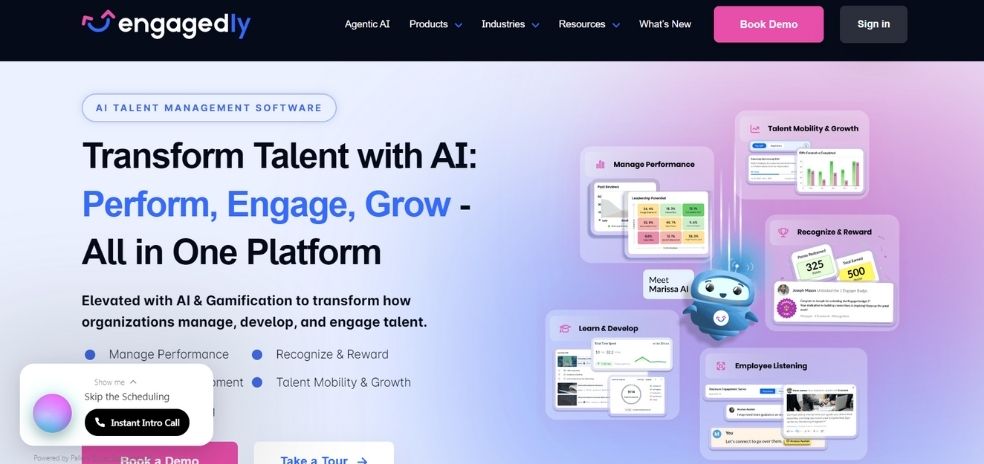
Engagedly is employee performance and engagement software with one-stop functionality. It includes 360-degree feedback, performance review, goal setting, learning management, and surveys. The platform promotes ongoing improvement through integrating development and engagement in one system. It is meant for HR leaders to help ensure workers’ goals meet company goals and monitor improvements effectively.
Engagedly is well-suited for big and medium businesses where there’s a pre-existing demand for comprehensive engagement solutions. Adding learning solutions is unique, and it also meets the requirements of those individuals who are anxious about both worker performance and professional development.
Features:
- 360-degree feedback
- Goal management
- Real-time feedback
- Learning management system
- Employee surveys
Pros:
- Highly customizable features
- Combines engagement with learning tools
Cons:
- Interface can feel cluttered
- Learning curve for new users
Who should use it:
Suitable for enterprises looking to integrate employee engagement with performance and learning.
8. Qualtrics EmployeeXM
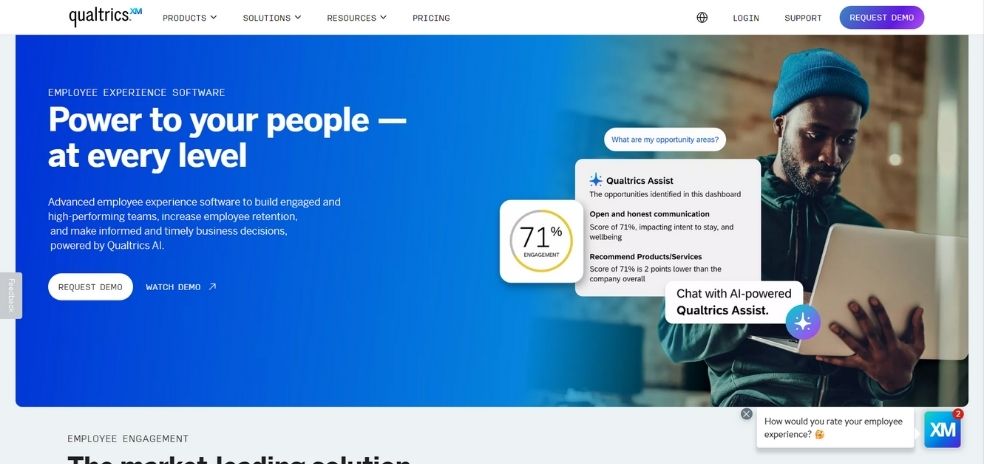
Qualtrics EmployeeXM offers a platform at an enterprise level for measuring and optimizing the employee experience. With high-powered survey ability, AI-powered analytics, and live dashboards, it equips businesses with the ability to see everything that matters about the employee experience. It captures feedback in real time and offers strategic suggestions, right from hire through separation.
It works best for larger organizations that need deep-level analysis and actionable recommendations. While it takes experience to wield it to maximum capacity, no other tool equals it in knowledge scope. Evidence-based HR departments would ideally utilize Qualtrics so that they would like to make decisions based on fact-supported data from employee experience and sentiment.
Features:
- Advanced survey builder
- AI-driven analytics
- Employee journey tracking
- Real-time dashboards
- Benchmarking and insights
Pros:
- Enterprise-grade analytics
- Deep insights into employee experience
Cons:
- Expensive for small businesses
- Complex setup process
Who should use it:
Ideal for large enterprises or organizations with a strong data-driven HR approach.
9. Peakon (Workday)
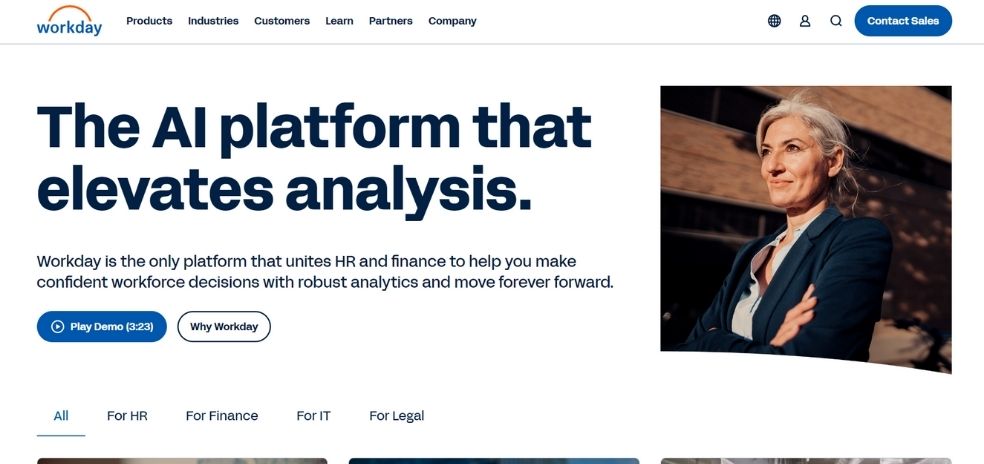
Peakon, now owned by Workday, is an employee engagement platform that captures feedback in real time and turns it into actual insights. Peakon utilizes AI to provide sentiment analysis and assist leaders with evidence-based choices. Peakon assists organizations in discovering drivers of engagement, keeping an eye on trends, and creating strategic plans to enhance.
It is designed for global enterprises and companies that have multi-tiered organizations and remote employees. While Peakon is an investment, its real-time access and integration simplicity with Workday position it as a product to use while scaling employee engagement. Suited for organizations already invested in the Workday universe.
Features:
- Continuous employee feedback
- AI-based insights
- Action planning tools
- Custom surveys
- Industry benchmarking
Pros:
- Provides real-time engagement data
- Scalable for global teams
Cons:
- High cost
- Requires Workday integration for full functionality
Who should use it:
Best for global enterprises using Workday looking for real-time engagement tracking.
10. Bonusly
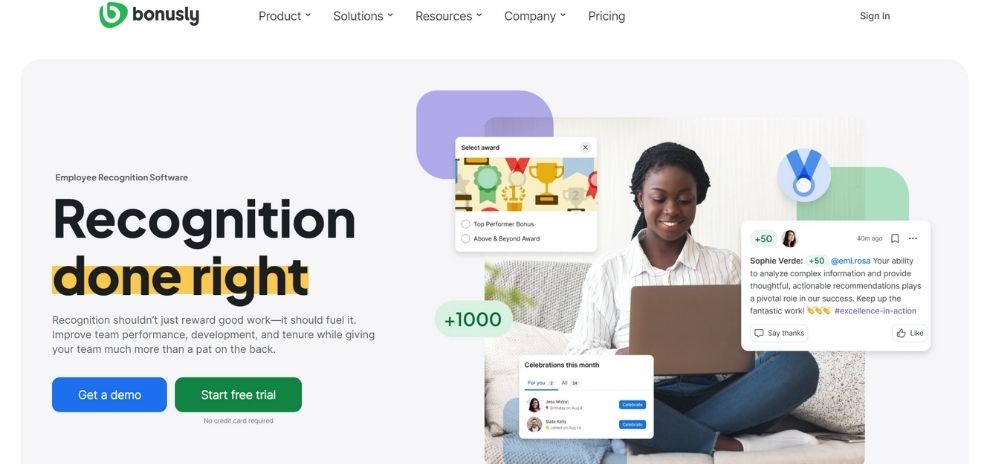
Bonusly is an easy, playful employee gratitude program that encourages peer-to-peer gratitude with a points-based reward system. Employees can give and receive micro-bonuses, which can be redeemed for real rewards. Bonusly can be integrated with Slack, Microsoft Teams, and other applications so that gratitude becomes part of the work process.
Bonusly’s real-time engagement platform and report feature help managers track participation and employee mood. It’s well-suited to companies that wish to promote appreciation and team spirit in an easy-going, friendly way. Accommodates any size team, especially hybrid and remote teams.
Features:
- Peer recognition with points
- Reward redemption system
- Engagement reporting
- Admin controls
- Integrations with Slack and Teams
Pros:
- Fun and engaging reward system
- Seamless integrations with daily tools
Cons:
- Focuses mostly on recognition
- Budget management needed for rewards
Who should use it:
Great for teams of all sizes who want to encourage frequent and fun recognition.
Explore more blogs on the best tools and software available online:
- Best Content Distribution Platforms
- Best Help Desk Ticketing Software
- Best SaaS Accounting Software
- Best Enterprise Resource Planning Software
- Best Financial Risk Management Software
Conclusion
To sum up, employee engagement software plays a great role in creating a healthy work culture, retention, and productivity. Among the many available tools, each of them has something special suited to different organizational needs. For example, Officevibe is a great choice for small and medium-sized teams who require simple but significant pulse surveys and feedback.
Culture Amp would suit HR departments that want heavy analytics and performance scores, while 15Five is suitable for ongoing performance management through weekly one-on-ones and tracking of goal progress. TinyPulse excels particularly at anonymous real-time feedback gathering in light form. Lattice offers end-to-end performance management, engagement, and career development.
Both Bonusly and Motivosity are focused on employee recognition, but Motivosity adds in peer-to-peer recognition, and Bonusly takes the lead in gamified micro-rewards. Engagedly is an integration of engagement, learning, and development, and is therefore best for companies that would prefer to tie performance to growth. For companies looking for great data and customization, both Qualtrics EmployeeXM and Peakon (Workday) feature high-end analytics as well as scalability.
Finally, the tool most suited will be based on your business’s size, needs, and available budget. Small teams may get value from applications like Officevibe or 15Five, while larger enterprises need to find data-intensive platforms like Qualtrics or Peakon. The two tools both have useful ingredients in a bid to create a healthy workplace.
FAQs
1. Which tool increases employee engagement?
An employee engagement tool is a software system used to track and improve the job satisfaction, motivations, and commitments of an organization’s employees. It is implementing it for acquiring feedback, tracking performance and building a positive company culture.
2. Why do companies need employee engagement tools?
They allow organizations to learn how employees think about them; where they can improve, lower turnover, increase productivity, and have more a motivated and engaged workforce.
3. Are Engagement tools for small organizations?
Yes, the fact that most of them such as Officevibe, TinyPulse and 15Five have solutions and plans that are suitable for small and medium-sized groups with small budgets.
4. What do I seek to find in an engagement tool?
Look for the following; pulse surveys, anonymous feedback, monitoring performance, peer-to-peer rewards, analytics and consolidation with the already existing HR systems.
5. What is the best tool for big corporations?
For difficult evaluation and customizing specific for massive operations, Qualtrics EmployeeXM, and Peakon (Workday) are appropriate because they have scalability and data-driven capacity.

